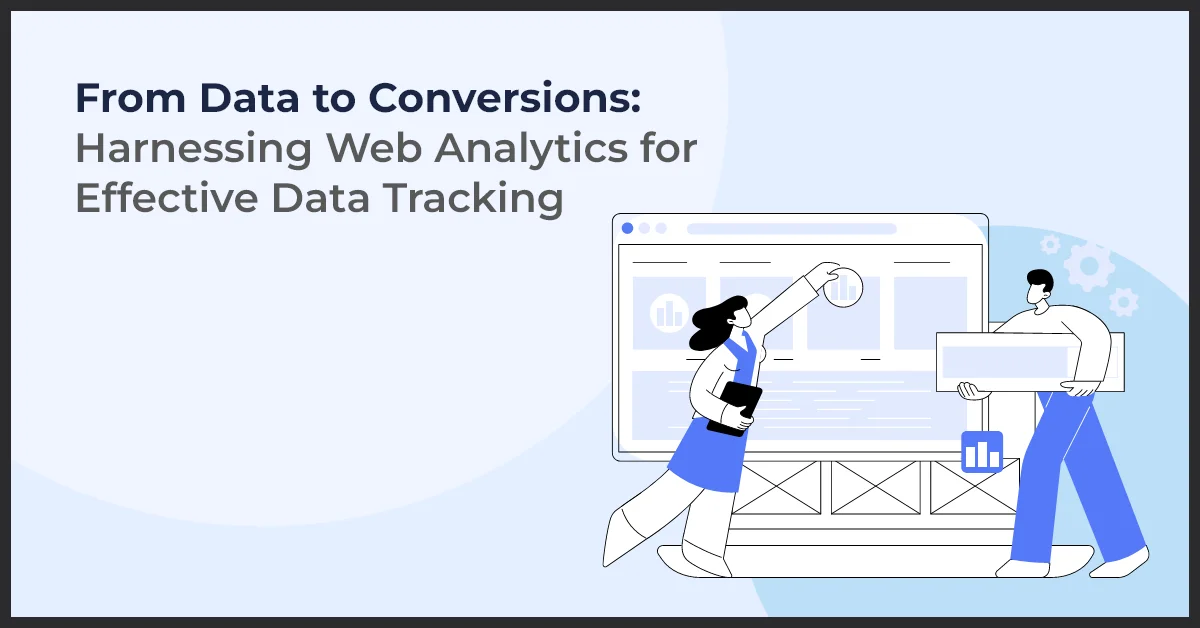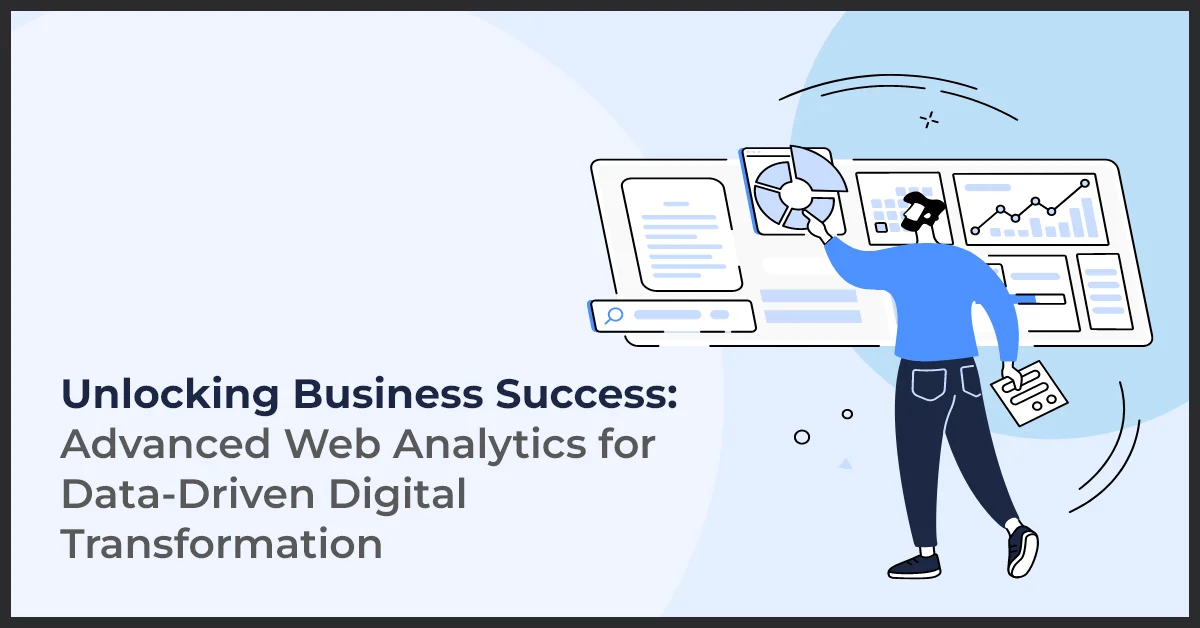From Data to Conversions: Harnessing Web Analytics for Effective Data Tracking

Published on: June 29, 2023
Updated on: October 21, 2024
1147 Views
- Web Analytics
10 min read
Every website tells a story—a story about how many people visited it, how many signed up for a webinar, downloaded an ebook, scheduled a demo, and so on. To get an accurate picture, tracking web analytics is essential. It lets you assess your website's current performance. Based on these analyses, you can conduct tests to enhance results.
Continue reading this blog as we explain how to track and analyze conversions with web analytics. We'll dive deeper into the benefits of tracking web analytics in optimizing conversions, what conversion types you can track, how to track website analytics, and much more. So, keep reading.
What Is Web Analytics?
Web analytics involves gathering, reporting, and analyzing data generated when users visit and engage with a website. Its primary goal is to measure user behavior, improve the user experience and website navigation, and extract valuable insights to support business objectives such as boosting conversions and driving sales.
Web analytics track the identity of a computer by placing a cookie on each device that visits the website. All this helps businesses make informed decisions and optimize their online presence for better results.
Benefits of Using Web Analytics for Optimizing Conversions
Tracking web page analytics helps you tailor your strategies to enhance conversion rates. It provides data-driven insights, identifies bottlenecks, and helps monitor key metrics. Here are some key benefits of utilizing web analytics for conversion optimization:
- Data-driven insights: Web analytics provide valuable data and insights about user behavior, allowing you to make informed decisions to optimize conversions.
- Identify bottlenecks: By analyzing user flow and behavior, web analytics help pinpoint areas in your conversion funnel where users drop off or face challenges, enabling you to address and optimize those bottlenecks.
- Performance tracking: Web analytics track key metrics such as conversion rates, bounce rates, and average session duration, providing a clear picture of how your website is performing and highlighting areas for improvement.
- Targeted optimization: With web analytics, you can segment and analyze user data to understand different audience segments, preferences, and behaviors to create impactful campaigns.
- Continuous improvement: By regularly monitoring and analyzing web analytics data, you can identify trends, track the impact of optimization efforts, and iterate on your strategies to achieve ongoing improvements in conversions and overall website performance.
Web Analytics and Its Role in Conversion Tracking
Web analytics is crucial in conversion tracking. It provides valuable data and insights about user behavior, interactions, and website performance. Here's how web analytics contributes to effective conversion tracking:
- Data Collection: Web analytics tools collect data on various metrics, including website traffic, user engagement, conversions, and more. This data serves as the foundation for conversion tracking.
- Conversion Measurement: Web analytics solutions enable you to set up conversion tracking, allowing you to define and track specific actions or events that indicate a conversion, such as form submissions, purchases, or account creations.
- Performance Analysis: Web analytics offers detailed reports and analysis on conversion rates, conversion paths, and user behavior. Use this information to understand how users interact with your website, identify bottlenecks, and uncover opportunities for optimization.
- A/B Testing: Web analytics lets you conduct A/B tests by comparing different versions of web pages or elements to determine which variations drive better conversion rates. It helps optimize your website for higher conversions.
- User Segmentation: With web analytics, you can easily segment your audience depending on its demographics, behavior, or other attributes. Gain insights into specific user groups, tailor marketing strategies, and optimize conversions for each segment.
- Goal Tracking and Funnels: Web analytics tools enable you to set goals and track the user journey through conversion funnels. Easily understand where users drop off or face obstacles to improve and increase conversion rates.
Types of Conversions to Track
When it comes to tracking conversions, various types of actions are considered valuable user interactions. Some of these are:
- Purchase Conversions: These track when a user completes a purchase on your website, indicating a successful transaction and revenue generation.
- Lead Generation Conversions: This type tracks when a user fills out a form, signs up for a newsletter, or requests more information, indicating an interest in your products or services.
- Account Creation Conversions: This conversion type tracks when a user creates an account on your platform, showing engagement and potential for long-term customer value.
- App Install Conversions: If you have a mobile app, tracking app installations as conversions helps measure the success of your app promotion efforts.
- Click-Through Conversions: These conversions track when users click on a specific link or CTA, redirecting them to a desired landing page.
- Engagement Conversions: This type tracks actions such as video views, social media shares, comments, or time spent on a specific page, indicating user engagement with your content.
How to Track and Analyze Conversions With Google Analytics
Most web analytics tracking tools have straightforward implementation. It usually involves setting up tracking codes and tags, defining the website's goals and actions (also known as events), and tracking conversions on multiple channels.
For the sake of an example, here's how to track your website traffic with Google Analytics:
Step 1: Create a Google Analytics account.
Go to the Google Analytics website: https://analytics.google.com/analytics/web/ and click "Create Account."
Enter your website's URL and other required information, then click "Create."
Step 2: Get your tracking ID.
After you create your Google Analytics account, you'll get a tracking ID. You will need this unique identifier to track your website traffic.
Where is the tracking ID in Google Analytics, you ask? It's in the Admin section of your Google Analytics account.
Step 3: Install the tracking code on your website.
Tracking code in web analytics is a script code you must add to your website to track your website traffic.
In Google Analytics, it’s a JavaScript code. There are different ways to install this code, but the simplest way is to use Google Tag Manager.
Step 4: Verify that the code works.
Once you have installed the tracking code, you must verify it works properly. You can do this by going to the Real Time report in Google Analytics.
If the tracking code works properly, you should see a list of current visitors on your website.
Step 5: Start analyzing your data.
Once you have verified that the tracking code works, you can analyze your data. Google Analytics provides a wealth of data about your website traffic, including the number of visitors, the pages they visit, and the actions they take.
You can use this data to improve your website and increase your conversions.
Some Additional Tips for Setting Up Google Analytics
- Use a tracking template. There are several tracking templates available that can help you to set up Google Analytics quickly and easily.
- Use event tracking. Event tracking allows you to track more complex interactions with your website, such as a user clicking a button or viewing a video.
- Use custom dimensions and metrics. These help you track additional information about your website traffic, such as the traffic's source or the conversion's value.
Aspects to Consider When Analyzing Conversion Data
As mentioned earlier, analyzing conversion data is essential for gaining insights into user behavior, optimizing conversions, and improving overall website performance. Here are vital aspects to consider when analyzing conversion data:
- Conversion Rates: Monitor and analyze conversion rates to understand how effectively your website drives desired actions. Identify high-converting pages or funnels and areas with lower conversion rates that may require optimization.
- User Behavior and Conversion Paths: Analyze user behavior data to understand how users navigate your website and interact with conversion-related elements. Examine users' conversion paths, identify common drop-off points, and optimize those areas to improve conversion rates.
- Segmentation and Demographic Analysis: Segment your audience based on demographics, behavior, or other attributes to uncover patterns and preferences among different user groups. Analyze conversion rates and behaviors specific to each segment to tailor your marketing strategies and optimize conversions for targeted audiences.
- Multi-Channel Attribution: Consider the multi-channel journey users take before converting. Analyze the impact of different marketing channels, like social media, organic search, or paid advertising, on conversions. Implement multi-channel attribution models to allocate credit accurately.
- A/B Testing and Experimentation: Conduct A/B tests to compare different versions of web pages, elements, or marketing strategies. Analyze the performance of variations and identify winning factors that drive higher conversion rates. Continuously experiment and optimize based on test results.
- Funnel Analysis: Use funnel analysis to track users' steps toward conversion. Identify drop-off points or bottlenecks within the funnel and improve the conversion process.
- Customer Journey Analysis: Know your customer's journey from the first touchpoint to conversion. Analyze user interactions at different stages and identify opportunities to enhance the user experience and drive more conversions.
- Heatmaps and User Session Recordings: Utilize heatmaps and user session recordings to visualize user behavior on your website. Gain insights into where users engage the most and where they encounter difficulties. Optimize these areas to enhance conversions.
- Mobile Optimization: Analyze conversion data specifically for mobile users. Optimize the mobile experience to ensure smooth navigation, fast loading times, and seamless conversions on mobile devices.
Top Web Analytics Tracking Tools
Whether a simple solution or a more complex web analytics tool for tracking your competitors look no further than these solutions.
- Google Analytics
This is a freemium tool that offers a wealth of data about your website traffic, including bounce rate, session duration, and conversion rates.
- Adobe Web Analytics
Adobe Analytics for web tracking has robust features like advanced segmentation, real-time data collection, customizable reporting, conversion tracking, path analysis, and integration with other Adobe Experience Cloud solutions.
- Matomo
This open-source alternative to Google Analytics offers many of the same features.
- Mixpanel
This tool specializes in tracking user behavior and engagement.
- Amplitude
This tool is similar to Mixpanel but also offers features for tracking mobile app usage.
- Heap
This tool uses session recordings to offer insights into how a user interacts with your website or app.
- Hotjar
This tool also uses session recordings and offers heatmaps and other features for visualizing user behavior.
- Clicky
This tool offers many features, including website traffic tracking, heatmaps, and A/B testing.
- SEMrush
This tool is more than just a web analytics tool. It also offers SEO, PPC, and social media marketing tools.
The best tool for you will depend on your specific needs and budget. If you are starting, Google Analytics is an excellent option because it is free and easy to use. Consider a paid tool like Mixpanel or Amplitude if you need more advanced features.
Conclusion
In conclusion, web analytics plays a vital role in understanding and optimizing conversions on your website. You can make informed decisions to enhance your website's performance and drive conversions by leveraging data-driven insights and tracking key metrics. Web analytics enables you to analyze user behavior, identify bottlenecks, segment your audience, and conduct A/B testing for continuous improvement.
Through implementing conversion tracking and using various web analytics tools, you gain valuable insights into user interactions, conversion rates, and the effectiveness of your marketing efforts. If you're looking for expert guidance and support in leveraging web analytics for your business, don't hesitate to reach out to Growth Natives at info@growthnatives.com or call our toll-free number +1 855-693-4769.
Our team will help you unlock the full potential of your website and achieve your conversion goals. Keep tracking, analyzing, and optimizing to achieve your conversion goals and maximize your online success.



